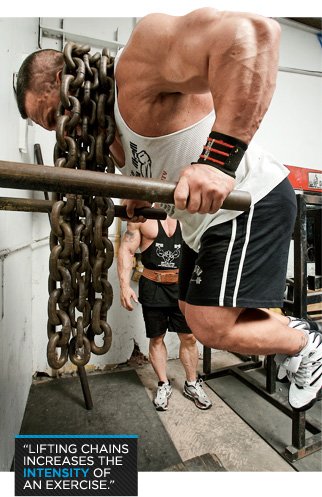Lifting chains works for bodybuilders for three reasons: 1) They help match the resistance curve of an exercise with the strength curve of a muscle; 2) they prolong the time under tension of an exercise; and 3) they increase the intensity of an exercise. Let's explore.
A strength curve, or force curve, is a mathematical model that represents how much force an individual can produce at a specific joint angle. This is in contrast to a resistance curve, which is how difficult an exercise is at specific points of the exercise. There are three basic types of strength curves: ascending, descending, and ascending-descending. An ascending strength curve refers to being able to display more force when you extend a joint, a descending strength curve refers to being able to display more force as you flex a joint, and an ascending-descending strength curve means you can display more strength at the midrange position of a joint. Lifting chains are best used for exercises that involve ascending strength curves so that the weight feels lighter as you get close to the end range of the exercise. Examples include squats, deadlifts, bench presses, and military presses.





An example of an exercise that lifting chains would not be good for is the pullup—in fact, one reason so many boot camp programs use kipping pullups is to utilize momentum to complete the movement. But just as doing cheat biceps curls doesn't necessarily enable you to do strict curls, kipping pullups (done with a hip snap) don't necessarily translate into strict pullups—plus consider the high levels of stress these Cirque du Soleil movements place on the shoulder joint.
In effect, what lifting chains does is provide variable resistance so you can match the strength curve of a muscle with the resistance curve of the exercise. Before chains became popular, partial movements were often used as a practical way to match the resistance curve of an exercise. For example, because a lifter is stronger at the finish of a deadlift, a powerlifter might perform deadlifts in a power rack with safety rods set up so that the barbell is positioned at knee height. As such, a powerlifter doing a 500-pound deadlift from the floor might be able to use 600 pounds with the bar set at knee height. As such, chains can be considered an "economical exercise," because rather than having to perform two or more variations of the same exercise, you need to perform only one since the weight of the barbell increases as the chain links are lifted off the floor.
The feedback I get from lifters is that exercises with chains feel "smooth" throughout the entire movement. Another advantage of using chains is that they slow down the concentric portion of the exercise, prolonging the time the muscle is under tension. It has the same effect as doing dropsets, which serve to increase the time a muscle is placed under tension. Generally, to stimulate maximal muscle growth, a muscle needs to be under tension for 40-70 seconds, another important factor in using the variable of workout intensity to your advantage. Intensity is defined according to how much an individual can lift in relation to how much weight they can lift for one repetition. High levels of intensity are necessary to work the fast-twitch muscle fibers, which must be activated for a bodybuilder to achieve the highest levels of muscular hypertrophy. Because lifting chains increases the amount of weight lifted during certain portions of an exercise, the intensity of the exercise is higher.
Chains also help trainees squat lower. If you want to achieve maximal muscle size in your lower extremities, you need to squat rock-bottom. Chains work on your subconscience to get you to squat lower, because the weight feels lighter as you go deeper. As a general guideline, you want to use chains that are roughly 10% of the barbell weight (bar + plates + collars). So if the loaded barbell weight is 100 kilos (220 pounds), each chain should weigh 10 kilos (22 pounds). But don't get too detail-oriented—even a 15% chain will do.
In my opinion dips are the quickest way to massive triceps. What, no pressdowns? Have you looked at the triceps of powerlifters and strongman competitors recently? They are plenty massive, and very few of those guys waste their time on pressdowns. Or look at gymnasts—they have massive triceps developed from many reps of dips and pressing motions. Yet, like the very demanding squats and chins, dips rarely make it into other fitness magazines—you know, the ones where the model always purses his lips for the picture. Too bad, because electromyography studies clearly show that dips activate the greatest amount of motor units in the triceps brachii.

To start the exercise, hold the handle bar and boost yourself until you are stabilized at arm's length over the handles, then lower your body as far as possible in between the bars; during this eccentric portion of this exercise you want to lower your body until your biceps make contact with your forearms—your triceps must get fully stretched. Once you reach the bottom position, press yourself back up by extending the elbows; try to stay as upright as possible throughout the range of motion. Don't lean too far forward because this will increase the recruitment of the pectoralis muscles.
If you can't lower yourself under control until the biceps make contact with the forearms, go back to collecting stamps—or you can perform the decline close-grip bench press until your elbow extension strength is sufficient. Doing an incomplete range in triceps dips is a complete waste of your time. And please do not go for the El Dweebo version, where you put your feet on a bench in front of you and put your hands behind you. That exercise, along with Smith machine pressing exercises, is one of the major causes of shoulder impingement syndromes in the bodybuilding community.
At first your body weight will probably suffice as the sole means of resistance. As you get stronger, you can increase the resistance by holding a dumbbell between your legs or hooking a plate or dumbbell onto a specialized chin/dip belt. There are many variations of chin/dip belts on the market, and in my opinion, most of them are not worth the money. I have always had the policy of "buy once, and for life." That is how high the quality of what you buy should be. Tree-climbing belts are the best choice, and they are designed to take the stress off the hips.
If you have access to the better V-shaped dipping bars, use as narrow a grip as possible, without compromising shoulder integrity, of course. And please, do not cheat yourself by doing chopped reps by not going all the way down, and by coming up only three-quarters of the way. By the same token, your elbows should go to only 98% of elbow extension to maintain maximal tension on the triceps. A great way to enhance the return on your investment in dips is to use chains to match the strength curve. Since dips have an ascending strength curve, you want more weight in the fully contracted position than in the stretched position. As you extend the arms, more chain links come off the floor, hence increasing the resistance on the triceps.

